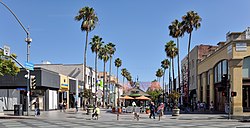 A picture taken in the heart of the Promenade in 2017 | |
 | |
| Location | Santa Monica, California, U.S. |
|---|---|
| Opening date | November 8, 1965 |
| Developer | The Hahn Company and The Rouse Company |
| Management | Downtown Santa Monica, Inc. |
| Owner | Multiple owners, including Federal Realty Investment Trust, [1] and KLM Equities [2] |
| Parking | Structured |
| Website | Third Street Promenade and Downtown Santa Monica |
The Third Street Promenade is a pedestrian mall esplanade, shopping, dining and entertainment complex in the downtown area of Santa Monica, California which originally opened as the Santa Monica Mall on November 8, 1965. [3] It is considered a premier shopping and dining district on the Westside and draws crowds from all over the Greater Los Angeles area. Due to easy access to Downtown Los Angeles via the Big Blue Bus rapid transit service, E Line's terminus station and the Pacific Coast Highway-Santa Monica Freeway Interstate, the neighborhood's north-south thoroughfares connecting to Muscle Beach, Venice Canal Historic District, Marina del Rey, Ballona Wetlands and Los Angeles International Airport, [4] and its proximity to historic U.S. Route 66, Santa Monica Pier, Palisades Park, Tongva Park, Santa Monica State Beach and the Pacific Ocean coupled with Los Angeles's mild mediterranean climate, it is also a popular tourist destination.


